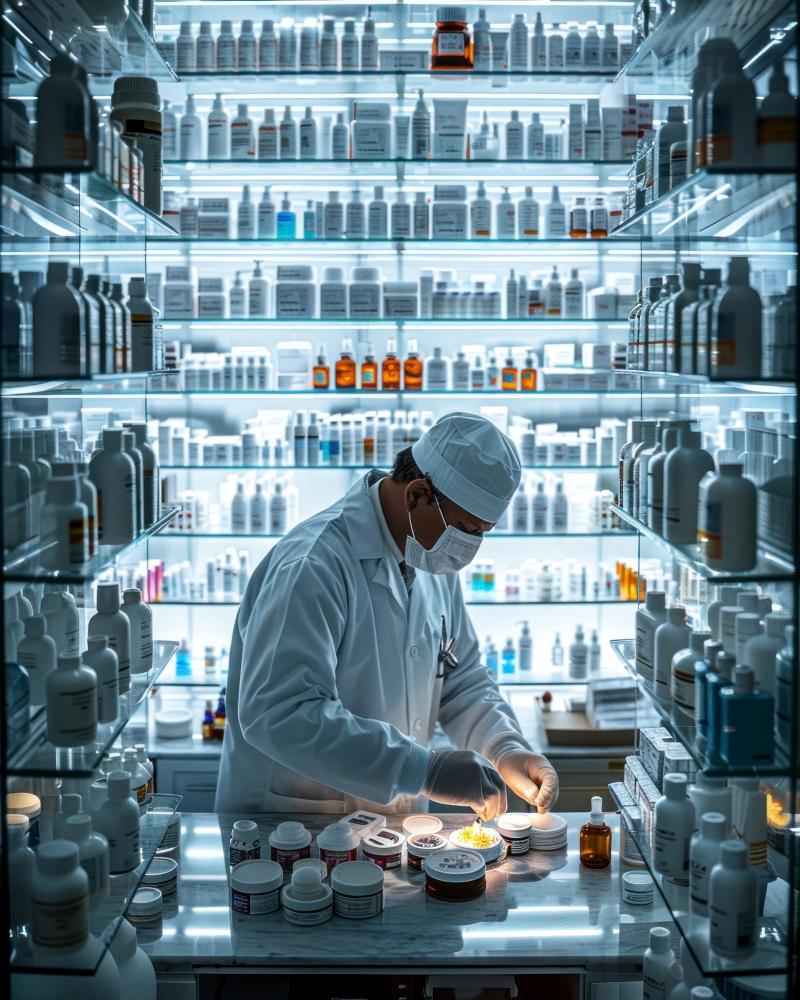United States Blockchain in Pharma Supply Chain Management – openPR.com

Blockchain in Pharmaceutical Supply Chain Management: A Report on Market Growth and Contribution to Sustainable Development Goals
Executive Summary
The global market for blockchain in pharmaceutical supply chain management is experiencing significant growth, driven by the urgent need to address critical global health and safety challenges. This technology is pivotal in enhancing drug traceability, ensuring data integrity, and combating the proliferation of counterfeit medicines. By fostering transparency and security, blockchain applications directly contribute to the achievement of several United Nations Sustainable Development Goals (SDGs), particularly SDG 3 (Good Health and Well-being), SDG 9 (Industry, Innovation, and Infrastructure), and SDG 16 (Peace, Justice, and Strong Institutions).
Market Overview and Growth Projections
The market for blockchain in the pharmaceutical supply chain is on a strong upward trajectory, reflecting its increasing adoption as a critical tool for industry integrity.
- 2024 Market Value: US$ 1.27 billion
- 2033 Projected Value: US$ 6.57 billion
- Compound Annual Growth Rate (CAGR) 2025-2033: 21.5%
This growth is propelled by the rising adoption of strategies by key industry players and a greater understanding of blockchain’s potential to create resilient and transparent supply chains.
Addressing Global Health Challenges (SDG 3: Good Health and Well-being)
The primary driver for blockchain adoption is its capacity to ensure access to safe, effective, and quality-assured medicines, a core target of SDG 3. The technology directly confronts the global crisis of counterfeit and substandard drugs.
The Scale of Counterfeit Pharmaceuticals
- The World Health Organization (WHO) estimates that 1 in 10 medicines in low- and middle-income countries is substandard or falsified, resulting in an annual economic cost of approximately US$ 30.5 billion.
- According to the Pharmaceutical Security Institute (PSI), 6,897 incidents of pharmaceutical crime were recorded across 142 countries in 2023.
- The U.S. National Institutes of Health (NIH) estimates that up to 15% of all drugs sold are fake, with this figure exceeding 50% in parts of Africa and Asia.
Blockchain as a Solution for Drug Safety and Quality Assurance
Blockchain provides an immutable and transparent ledger for tracking pharmaceuticals from manufacturer to patient, significantly enhancing quality assurance and patient safety.
- Drug Traceability: Solutions like Merck’s M-Trace Software & Mobile App, launched in May 2024, digitize testing and verification processes, ensuring drug authenticity.
- Data Security: With healthcare data breaches affecting 112 million individuals in 2023, blockchain offers enhanced security for sensitive supply chain and patient data.
- Quality Control: Integration with IoT devices (e.g., temperature sensors) ensures the integrity of the cold chain for vaccines and biologics, creating a tamper-proof history of a product’s journey.
Fostering Innovation and Resilient Infrastructure (SDG 9: Industry, Innovation, and Infrastructure)
The implementation of blockchain represents a significant technological innovation that builds resilient and sustainable infrastructure within the pharmaceutical industry, aligning with the objectives of SDG 9.
Key Technological Developments and Applications
- Smart Contracts: Automation of compliance checks, supplier qualifications, and payment settlements.
- Inventory Monitoring: Real-time visibility into supply chain logistics, reducing waste and improving efficiency.
- Compliance Management: Streamlined adherence to regulatory standards through automated and transparent record-keeping.
Corporate and Strategic Initiatives
Major technology and pharmaceutical companies are driving innovation through strategic acquisitions and collaborations.
- Key Players: IBM, Microsoft, SAP SE, Oracle, Amazon Web Services, Inc., FarmaTrust, and others are leading the market.
- M&A Activity: Large technology providers are acquiring specialized blockchain firms like Chronicled and FarmaTrust to expand their capabilities in secure drug traceability.
- Collaborations: Firms such as Pfizer and IBM are collaborating on platforms to improve drug authenticity verification and streamline recall processes.
Enhancing Governance and Institutional Integrity (SDG 16 & 17: Peace, Justice, and Strong Institutions; Partnerships for the Goals)
Blockchain technology promotes the development of effective, accountable, and transparent institutions by combating illicit activities and fostering global partnerships, directly supporting SDG 16 and SDG 17.
Regulatory Frameworks and Compliance
Global regulatory bodies are increasingly recognizing blockchain as a tool to enforce compliance and enhance data integrity.
- The U.S. FDA encourages blockchain pilots under the Drug Supply Chain Security Act (DSCSA) to improve traceability.
- The technology supports compliance with global standards such as the EU’s Falsified Medicines Directive and data privacy laws like HIPAA and GDPR.
- Blockchain’s immutable audit trails align with regulations for electronic records, such as 21 CFR Part 11.
Global Partnerships and Implementations
Cross-sector and international collaborations are essential for leveraging blockchain to achieve global health security.
- In November 2024, Ethiopia’s Food and Drug Authority (EFDA) partnered with Medical Value Chain to implement a blockchain-based track-and-trace system.
- In September 2023, Mauritius launched a blockchain-based eVerify system for electronic authentication.
- India’s National Blockchain Framework is actively supporting adoption in the pharmaceutical sector to enhance data transparency.
Market Segmentation and Regional Outlook
Key Market Segments
- By Offerings: Platform, Service
- By Application: Drug Traceability, Inventory Monitoring, Smart Contracts, Compliance Management, Payment & Settlement
- By Type: Private Blockchain, Public Blockchain, Hybrid Blockchain
- By End User: Manufacturers, Distributors, Healthcare Providers
Regional Analysis
The market demonstrates a global presence, with significant activity across major regions.
- North America: U.S., Canada, Mexico
- Europe: U.K., Germany, France, Italy, Spain
- Asia-Pacific: China, Japan, India, South Korea, Australia
- South America: Brazil, Argentina, Colombia
- Middle East & Africa: Saudi Arabia, U.A.E., South Africa
North America’s market dominance is reinforced by strong regulatory drivers and high-profile cases, such as the FDA’s alerts for counterfeit Botox and Ozempic injections.
Analysis of SDGs, Targets, and Indicators
1. Which SDGs are addressed or connected to the issues highlighted in the article?
The article highlights issues and solutions that are directly connected to several Sustainable Development Goals (SDGs). The primary focus on combating counterfeit drugs, enhancing patient safety, and improving healthcare infrastructure through technology links directly to the following SDGs:
- SDG 3: Good Health and Well-being: The core theme of the article is ensuring the safety and authenticity of pharmaceuticals. By addressing the problem of counterfeit, substandard, and falsified medicines, which the WHO estimates affect 1 in 10 people in low- and middle-income countries, the use of blockchain directly contributes to ensuring healthy lives and promoting well-being.
- SDG 9: Industry, Innovation, and Infrastructure: The article centers on a technological innovation (blockchain) being applied to upgrade the pharmaceutical industry’s supply chain infrastructure. It discusses market growth, investment in new technology, and collaborations to build resilient and secure systems, such as the track-and-trace system implemented in Ethiopia.
- SDG 16: Peace, Justice, and Strong Institutions: This goal is relevant because the trade in counterfeit pharmaceuticals is a form of organized crime involving illicit flows. The article notes 6,897 incidents of pharmaceutical crime and 4,894 arrests in 2023. Blockchain technology helps build transparent and accountable institutions (e.g., regulatory bodies like the FDA and EFDA) by creating immutable audit trails that combat this illicit trade.
- SDG 17: Partnerships for the Goals: The article provides multiple examples of partnerships crucial for achieving these goals. These include public-private partnerships (Ethiopia’s Food and Drug Authority with Medical Value Chain), corporate collaborations (Pfizer and IBM), and adherence to international standards (WHO, EU’s Falsified Medicines Directive), which are all central to the spirit of SDG 17.
2. What specific targets under those SDGs can be identified based on the article’s content?
Based on the issues discussed, several specific SDG targets can be identified:
- Target 3.8: Achieve universal health coverage, including access to safe, effective, quality and affordable essential medicines and vaccines for all. The article’s entire focus on using blockchain to eliminate counterfeit drugs and ensure drug authenticity directly supports the goal of providing access to “safe, effective, quality” medicines.
- Target 3.d: Strengthen the capacity of all countries, in particular developing countries, for early warning, risk reduction and management of national and global health risks. The implementation of a blockchain-enabled track-and-trace system in Ethiopia is a direct example of strengthening a developing country’s capacity to manage the global health risk posed by counterfeit drugs.
- Target 9.5: Enhance scientific research, upgrade the technological capabilities of industrial sectors in all countries, in particular developing countries. The article highlights the adoption of emerging technologies like blockchain, AI, and big data in countries like Ethiopia and Mauritius to upgrade their healthcare and pharmaceutical sectors.
- Target 16.4: By 2030, significantly reduce illicit financial and arms flows… and combat all forms of organized crime. The fight against the multi-billion dollar counterfeit drug market, which the article describes as involving “counterfeiting, theft, and illegal diversion,” is a direct contribution to combating organized crime and reducing illicit flows of goods.
- Target 17.17: Encourage and promote effective public, public-private and civil society partnerships. The partnership mentioned between Ethiopia’s Food and Drug Authority (a public body) and Medical Value Chain (a private company) to implement a national track-and-trace system is a clear example of this target in action.
3. Are there any indicators mentioned or implied in the article that can be used to measure progress towards the identified targets?
The article contains several statistics and data points that can serve as direct or implied indicators to measure progress:
- Proportion of substandard or falsified medicines: The article cites the WHO’s estimate that “1 in 10 medicines in low- and middle-income countries are substandard or falsified” and the NIH’s estimate that “up to 15% of drugs sold are fake.” A reduction in these percentages would be a key indicator of progress towards Target 3.8.
- Incidents of pharmaceutical crime: The article mentions the Pharmaceutical Security Institute (PSI) recorded “6,897 incidents of pharmaceutical counterfeiting, theft, and illegal diversion” in 2023. Tracking this number annually would measure progress against Target 16.4.
- Economic losses from counterfeit drugs: The article states that falsified medicines cost around “US$30.5 billion annually.” A decrease in this financial figure would indicate success in securing the supply chain.
- Number of healthcare data breaches: The article notes that in 2023, “112 million individuals were affected” by healthcare data breaches. A reduction in the number of breaches and affected individuals would indicate improved data security, a benefit of blockchain implementation.
- Market growth of supply chain technology: The forecast that the “market reached US$ 1.27 billion in 2024 and is expected to reach US$ 6.57 billion by 2033” serves as an indicator of the rate of adoption of innovative technologies, relevant to Target 9.5.
SDGs, Targets and Indicators
| SDGs | Targets | Indicators |
|---|---|---|
| SDG 3: Good Health and Well-being | 3.8: Access to safe, effective, quality and affordable essential medicines.
3.d: Strengthen capacity for management of national and global health risks. |
– Proportion of medicines that are substandard or falsified (Article cites 1 in 10 in low/middle-income countries). – Economic losses due to falsified medicines (Article cites US$30.5 billion annually). |
| SDG 9: Industry, Innovation, and Infrastructure | 9.5: Upgrade the technological capabilities of industrial sectors in all countries. | – Market size and growth rate for blockchain in pharma supply chain (Article cites growth from US$1.27B in 2024 to US$6.57B by 2033). – Number of countries implementing advanced technological systems (Article mentions Ethiopia and Mauritius). |
| SDG 16: Peace, Justice, and Strong Institutions | 16.4: Significantly reduce illicit flows and combat all forms of organized crime.
16.6: Develop effective, accountable and transparent institutions. |
– Number of incidents of pharmaceutical crime (Article cites 6,897 incidents in 2023). – Number of arrests related to pharmaceutical crime (Article cites 4,894 arrests in 2023). – Number of healthcare data breaches and individuals affected (Article cites 112 million individuals in 2023). |
| SDG 17: Partnerships for the Goals | 17.17: Encourage and promote effective public, public-private and civil society partnerships. | – Number of public-private partnerships for technology implementation (Article cites Ethiopia’s FDA partnering with Medical Value Chain). – Number of corporate collaborations on technology platforms (Article cites Pfizer and IBM). |
Source: openpr.com
What is Your Reaction?
 Like
0
Like
0
 Dislike
0
Dislike
0
 Love
0
Love
0
 Funny
0
Funny
0
 Angry
0
Angry
0
 Sad
0
Sad
0
 Wow
0
Wow
0
















































/environment-climate-change-and-health-(ech)/water-sanitation-hygiene-and-health-(wsh)/landfill-tuvalu-36092.tmb-1200v.jpg?sfvrsn=5c21fe40_1#)

.jpg.webp?itok=0ZsAnae9#)
























